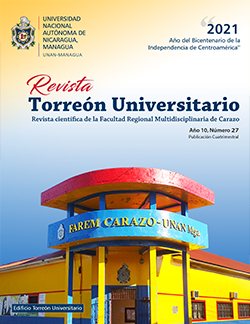Lipolytic activity of fungi isolated from used cooking oil and machine shop floors
DOI:
https://doi.org/10.5377/torreon.v10i27.10845Keywords:
Lipolytic fungi, lipase, enzyme activity, used cooking oilAbstract
The objective of the research was to select the genus with the highest enzymatic activity by using used cooking oil as the only source of the substrate. Fungi were isolated from used cooking oil and from contaminated soils by mechanical car repair shops. The samples were inoculated in general fungal media (PDA agar), when obtaining axenic cultures they were inoculated in selective agar for lipolytic fungi (tributyrin agar), the genus were identified by bright field microscopy and phase contrast. In the selective medium, the presence of halo around the colony or crystallization close to the colony was considered as an indicator of lipolytic genus. The genus identified in soil were Fusarium and Aspergillus, the genus Aspergillus was identified in the oil. The tests were carried out with aeration, without aeration, in the tests without aeration, the interaction between the genuses isolated from the soil was evaluated, which was named consortium. The enzymatic activity in the first phase for the genus Aspergillus in tests without aeration, isolated from the oil was 0.0148 (U / ml). For Aspergillus and Fusarium isolated from the soil, the enzymatic activity was 0.0051 and 0.0055 (U / ml) respectively; in the consortium it was 0.003 U / ml. The genus Aspergillus isolated from the oil showed higher enzymatic activity and was selected for the second phase of lipolytic activity measurement. The highest enzymatic activity 0.0777 (U / ml) was obtained at 144 hours, when the culture was evaluated with aeration interrupted and continuous feeding. When the cultures were subjected to an aeration interrupted and discontinuous feeding, the enzymatic activity was similar to that achieved without aeration (0.026 and 0.034 (U / ml) respectively). These results suggest that the genus studied are capable of utilize used cooking oil as the only carbon source for their metabolic processes.
Downloads
Downloads
Published
How to Cite
Issue
Section
License
Los autores que publican en esta revista están de acuerdo con los siguientes términos.
- El autor o los autores de los artículos, ensayos o investigaciones conceden a la Universidad Nacional Autónoma de Nicaragua, Managua (UNAN-Managua) los derechos de edición (copyright) del trabajo enviado, por consiguiente la Universidad cuenta con el derecho exclusivo para publicar el artículo durante el periodo completo de los derechos de autor.
- Estos derechos de autor/ autores autorizan a la Revista Torreón Universitario y a la Universidad editar y divulgar/publicar el artículo en dicha Revista, incluyendo reproducción impresa y electrónica, el almacenamiento, recuperación y cualquier otro tipo de publicación, y fuentes de información secundaria como servicios de resúmenes y bases de datos, así mismo la facultan a proteger el artículo contra el uso no autorizado para su difusión por medios impresos o electrónicos (PDF, HTML, EPUB, XML u otros).
Licencia para el uso del contenido
La revista hace uso de la Licencia Creative Commons Atribución-NoComercial-SinDerivar 4.0 Internacional.
Bajo esta declaración:

Este revista está sujeta a una licencia de Creative Commons Reconocimiento-NoComercial-SinObraDerivada 4.0 Internacional. Puede ser copiada, distribuida y transmitida públicamente siempre y cuando se cite al autor y la fuente (Revista Torreón Universitario), no debe modificarse ni utilizarse con ningún fin comercial. La licencia completa se puede consultar en http://creativecommons.org/licenses/by-nc-nd/4.0/.

